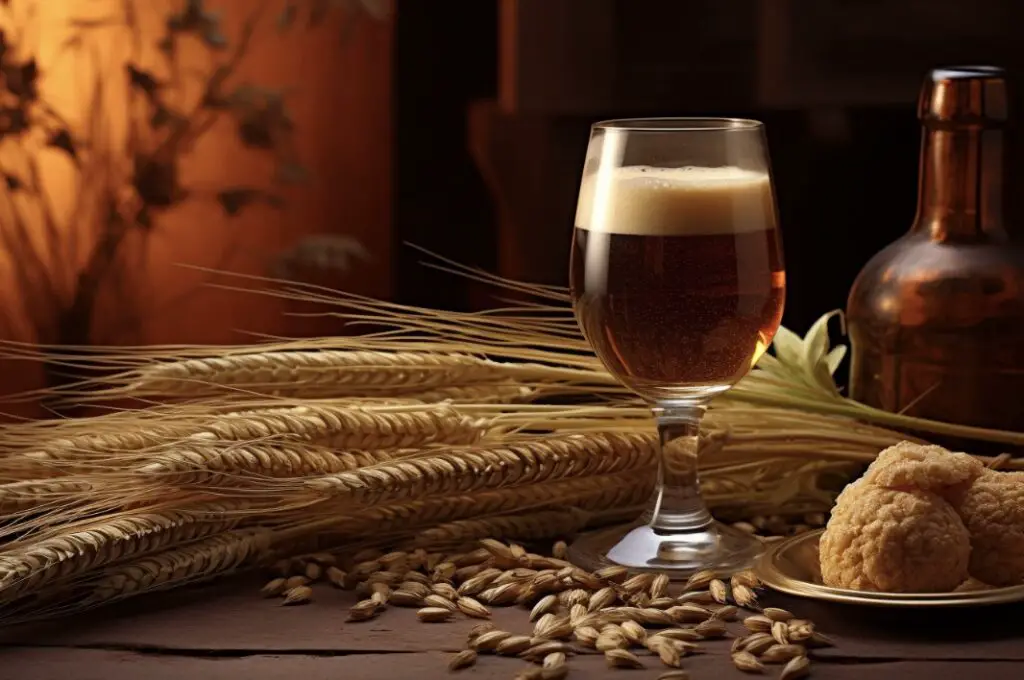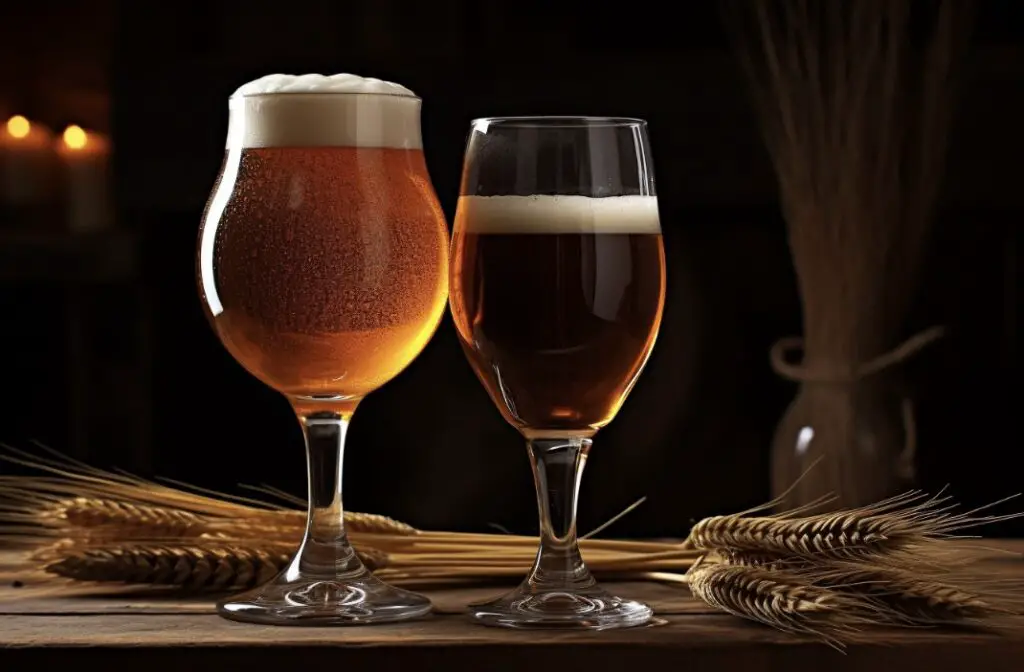Yes, barleywines are carbonated but the level of carbonation may vary depending on the brewer’s preference, style, and methods.
On average, Barleywines have carbonation levels ranging from 1.5 to 2.3 volumes of CO2. That is somewhat lower than the average beer especially lagers.
In comparison, some popular beers like Budweiser or Heineken contain 2.7 and 2.3 volumes of CO2, respectively.
However, barley wine is an ale, an ales (especially high alcohol ones) generally contain less carbonation than lagers and wheat beers.
In this blog post, I will discuss my personal experience with brewing and enjoying barleywines, their carbonation levels, and other fascinating aspects of this unique style of beer.
A Brief History of Barleywine
Barleywine has been around for centuries, with its roots tracing back to ancient brewing traditions in Europe. The term “barleywine” refers to the strong, high-alcohol content beer that was made by using an abundance of barley malt and a lengthy fermentation process.

Barleywines are typically aged for an extended period, often in oak barrels, to develop their complex flavors and aromas.
Traditional English Barleywines
English barleywines were the original style, characterized by their rich, malty sweetness and fruity esters.
They are typically less hoppy than their American counterparts, with a focus on the malt profile and a smooth, warming finish.
Carbonation in English barleywines is generally low to moderate (2 or less volumes of CO2), providing a more vinous, wine-like mouthfeel.
American Barleywines
American barleywines have taken the traditional English style and added a distinctly American twist, with a more aggressive hop presence and higher alcohol content.
These barleywines can be quite bitter and resinous, with a more assertive carbonation level to balance the intense flavors.
Carbonation in American barleywines can range from moderate to high, depending on the brewer’s preference and techniques.
What is the difference between ordinary beer and Barleywine?
Beer and Barleywine are both alcoholic beverages, but they differ in several key aspects.

Firstly, their alcohol content varies significantly. Beer typically has an alcohol content ranging from 3% to 8%, while Barleywine is much stronger, with an alcohol content ranging from 8% to 15% or even higher.
Secondly, the brewing process for these two beverages differs. Beer is brewed using a combination of malted barley, water, hops, and yeast, resulting in a fermented beverage. Barleywine, on the other hand, is a strong ale that uses a higher proportion of malted barley, resulting in a more robust and complex flavor profile.
Furthermore, the flavor profiles of beer and Barleywine also differ. Beer can have a wide range of flavors, from light and crisp to dark and malty, depending on the style. Barleywine, as the name suggests, tends to have a rich, malt-forward character with intense flavors of caramel, toffee, and sometimes even fruity or hoppy notes.
Lastly, the serving and aging of these beverages vary. Beer is typically consumed fresh and often served chilled, while Barleywine is often aged for several months or even years to allow the flavors to mellow and develop. Barleywine is often enjoyed at cellar temperature or slightly warmer to fully appreciate its complex flavors and aromas.
In summary, the key differences between beer and Barleywine lie in their alcohol content, brewing process, flavor profiles, and aging characteristics.
The Importance of Carbonation in Barleywine
Carbonation plays a crucial role in the overall experience of drinking a barleywine. It helps to lift and carry the flavors and aromas, making them more pronounced on the palate.

The level of carbonation can significantly impact the mouthfeel, balance, and drinkability of a barleywine.
Check out our bottle carbonation calculator to learn more about carbonation and how much priming sugar to add for perfect bottle conditioning!
Low Carbonation
Low carbonation in a barleywine can result in a silky, smooth mouthfeel and a more wine-like experience not too different from many stouts and porters.
This is common in traditional English barleywines, where the focus is on the malt profile and the complex flavors that develop during aging.
Low carbonation can make the beer feel more decadent and sippable, perfect for slow enjoyment on a chilly evening.
Moderate Carbonation
Moderate carbonation in a barleywine strikes a balance between the smooth, wine-like character of a low-carbonation brew and the lively, effervescent quality of a highly carbonated beer. This level of carbonation can provide a pleasant, refreshing mouthfeel while still allowing the rich, complex flavors to shine through.
High Carbonation
High carbonation in a barleywine can create a more effervescent and lively mouthfeel, which can help to cut through the intense flavors and high alcohol content.
Everything is relative though, and when we brew “highly” carbonated barley wines, we aim for around 2 to 2.5 volumes of CO2. So nothing crazy.

This is common in American barleywines, where the increased bitterness and hop presence are balanced by the higher carbonation level.
High carbonation can make the beer feel more refreshing and drinkable, despite its high alcohol content and bold flavors.
Bottle Conditioning and Carbonation
Bottle conditioning is a popular method for carbonating barleywines and other high-alcohol beers. This process involves adding a small amount of fermentable sugar and yeast to the beer before bottling, allowing for a secondary fermentation to occur within the bottle.
The carbon dioxide produced by the yeast during this fermentation is trapped in the bottle, naturally carbonating the beer.
Pros of Bottle Conditioning
Bottle conditioning offers several advantages for barleywines, including:
- Improved flavor development: The additional fermentation can help to further develop the complex flavors and aromas of the barleywine.
- Natural carbonation: The carbonation produced through bottle conditioning is often described as being softer and more refined than forced carbonation.
- Improved shelf life: The presence of live yeast in the bottle can help to prolong the beer’s shelf life and improve its aging potential.
Cons of Bottle Conditioning
However, there are also some potential drawbacks to bottle conditioning, such as:
- Inconsistency: The carbonation levels can vary between bottles, depending on factors like the amount of yeast and sugar added, and the storage conditions.
- Sediment: The yeast used for bottle conditioning can settle at the bottom of the bottle, creating a layer of sediment that may need to be carefully decanted when pouring the beer.
Conclusion
In conclusion, barleywines are indeed carbonated but the level of carbonation can vary depending on the style, brewing techniques, and preferences of the brewer.
Carbonation plays an essential role in the overall experience of drinking a barleywine, impacting the mouthfeel, balance, and drinkability of the beer. Whether you prefer a traditional, low-carbonation
English barleywine or a lively, high-carbonation American barleywine, there is a barleywine out there to suit your tastes.
10 Fun Facts About Barleywine
1. Barleywine originated in Europe, with a history dating back centuries.
2. Traditional English barleywines are known for their rich, malty sweetness and fruity esters.
3. American barleywines are characterized by their aggressive hop presence and higher alcohol content.
4. Barleywines are typically aged for an extended period to develop their complex flavors.
5. The level of carbonation in barleywines can vary depending on the style and brewing techniques.
6. Low carbonation in barleywines can result in a silky, wine-like mouthfeel.
7. High carbonation in barleywines can create a refreshing and effervescent drinking experience.
8. Bottle conditioning is a popular method for carbonating barleywines, allowing for natural carbonation and improved flavor development.
9. The carbonation levels in bottle-conditioned barleywines can vary, leading to potential inconsistencies between bottles.
10. Whether you prefer a low or high carbonation level, there is a barleywine to suit every palate.
FAQs
Does barley wine taste like beer?
Yes, barley wine does taste like beer, but it typically has a higher alcohol content and a more complex flavor profile. It often exhibits rich maltiness, fruity and caramel notes, and a strong hop presence. The higher alcohol content contributes to a warming sensation and a fuller body, making it distinct from regular beer.
Is Barleywine an ale or lager?
Barleywine is classified as an ale. It is a strong and robust beer style that is typically fermented with ale yeast and showcases rich malt flavors and high alcohol content.
What is the difference between stout and Barleywine?
Stout and Barleywine are both beer styles, but they differ in several key aspects. Stout is a dark beer with a roasted malt flavor, often featuring notes of chocolate or coffee. It tends to have a lower alcohol content and a drier, more balanced taste.
Barleywine, on the other hand, is a strong ale with a high alcohol content, typically ranging from 8% to 15% or even higher. It has a rich and complex malt profile, often showcasing fruity, caramel, or toffee flavors. Barleywines also tend to have a higher residual sweetness compared to stouts.
What are the characteristics of American Barleywine?
American Barleywine is a strong, malt-forward beer style known for its high alcohol content and intense flavors. It typically has a deep amber to dark brown color with a thick, persistent head. American Barleywines exhibit a rich, complex malt profile with notes of caramel, toffee, and sometimes toasted or roasted flavors.
They often have a significant hop presence, offering a balance to the malt sweetness with flavors ranging from citrusy and fruity to resinous and piney. The alcohol content is usually high, ranging from 8% to 15% ABV, and the body is full and chewy. American Barleywines are often aged to enhance their flavors and can develop additional characteristics such as sherry-like or vinous qualities over time.




